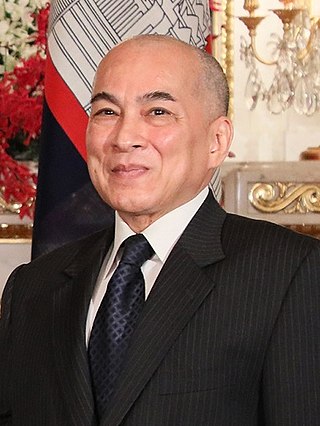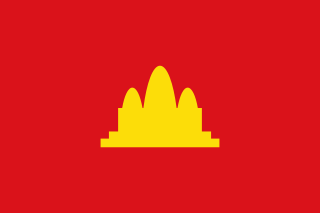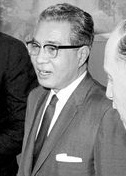| |||||
| Decades: | |||||
|---|---|---|---|---|---|
| See also: | Other events of 1954 List of years in Cambodia | ||||
The following lists events that happened during 1954 in Cambodia .
| |||||
| Decades: | |||||
|---|---|---|---|---|---|
| See also: | Other events of 1954 List of years in Cambodia | ||||
The following lists events that happened during 1954 in Cambodia .

Norodom Sihanouk was a member of the Cambodian royal house who led the country as King and Prime Minister. In Cambodia, he is known as Samdech Euv. During his lifetime, Cambodia was under various regimes, from French colonial rule, a Japanese puppet state (1945), an independent kingdom (1953–1970), a military republic (1970–1975), the Khmer Rouge regime (1975–1979), a Vietnamese-backed communist regime (1979–1989), a transitional communist regime (1989–1993) to eventually another kingdom.

The Khmer Republic was a Cambodian state under the United States-backed military dictatorship of Marshal Lon Nol from 1970 to 1975. Its establishment was formally declared on 9 October 1970, following the 18 March 1970 coup d'état which saw the overthrow of Norodom Sihanouk's government and the abolishment of the Cambodian monarchy.

The French protectorate of Cambodia refers to the Kingdom of Cambodia when it was a French protectorate within French Indochina, a collection of Southeast Asian protectorates within the French colonial empire. The protectorate was established in 1863 when the Cambodian King Norodom requested the establishment of a French protectorate over his country, meanwhile Siam renounced suzerainty over Cambodia and officially recognised the French protectorate on Cambodia.

Norodom Suramarit was King of Cambodia from 3 March 1955 until his death in 1960. He was the father of King Norodom Sihanouk and the grandfather of Cambodia's current king, Norodom Sihamoni. Suramarit was born in Phnom Penh to Prince Norodom Sutharot. When his grandfather King Norodom died in 1904, Norodom's brother Sisowath took the throne. King Sisowath died in 1927 and was succeeded by his son Monivong.

Norodom Sihamoni is King of Cambodia. He became King on 14 October 2004, a week after the abdication of his father, Norodom Sihanouk.

Norodom Chakrapong is a Cambodian politician, businessman and former major-general of the Royal Cambodian Armed Forces. He is the fourth son of Norodom Sihanouk of Cambodia and also a half-brother of the current king, Norodom Sihamoni. Chakrapong started his career as a military pilot in 1963. After Sihanouk was overthrown in 1970, Chakrapong spent time under house arrest, then in Beijing as the Head of Protocol of then-Prince Sihanouk, afterwards living overseas before he joined the Funcinpec in 1981 and fought against Vietnamese occupation as a commander of the Armée Nationale Sihanoukiste. In 1991, Chakrapong left Funcinpec to join the Cambodian People's Party (CPP) and served as the Deputy Prime Minister of Cambodia between 1992 and 1993. When the CPP lost the 1993 general elections, Chakrapong led a secession attempt in 1993. In 1994, he was accused of joining a failed coup attempt which led him to be sent into exile. After Chakrapong was pardoned in 1998, he founded a private airline company, Royal Phnom Penh Airways. The airlines later stopped all operations in early 2006.

Ang Duong was the King of Cambodia from 1848 to his death in 1860. Formally invested in 1848, his rule benefited a kingdom that had suffered from several centuries of royal dissent and decline.
The 1970 Cambodian coup d'état was the removal of the Cambodian Chief of State, Prince Norodom Sihanouk, after a vote in the National Assembly on 18 March 1970. Emergency powers were subsequently invoked by the Prime Minister Lon Nol, who became effective head of state, and led ultimately to the removal of Queen Sisowath Kossamak and the proclamation of the Khmer Republic later that year. It is generally seen as a turning point in the Cambodian Civil War. No longer a monarchy, Cambodia was semi-officially called "État du Cambodge" in the intervening six months after the coup, until the republic was proclaimed.

The Coalition Government of Democratic Kampuchea, renamed in 1990 to the National Government of Cambodia, was a coalition government in exile composed of three Cambodian political factions, namely Prince Norodom Sihanouk's FUNCINPEC party, the Party of Democratic Kampuchea and the Khmer People's National Liberation Front (KPNLF) formed in 1982, broadening the de facto deposed Democratic Kampuchea regime. For most of its existence, it was the internationally recognized government of Cambodia.

Operation Patio was a covert aerial interdiction effort conducted by the U.S. Seventh Air Force in Cambodia from 24 to 29 April 1970 during the Vietnam War. It served as a tactical adjunct to the heavier B-52 Stratofortress bombing missions being carried out in Operation Menu.

Norodom Monineath Sihanouk is the Queen Mother of Cambodia. She was Queen of Cambodia from 1993 to 2004, as the wife of King Norodom Sihanouk. She is the widow of King-Father Norodom Sihanouk, whom she married in 1955 as the "secondary consort". After Sihanouk and Norleak divorced in 1968, Monineath became the official spouse of the King.
The CIA conducted secret operations in Cambodia and Laos for eight years as part of the conflict against Communist North Vietnam.

Chau Sen Cocsal, also known as Chhum, was a Cambodian civil servant and politician who served as Prime Minister of Cambodia in 1962 and President of the National Assembly twice, in 1962–1963 and 1966–1968. Chhum was awarded the honorary title "Samdech" in 1993 by King Norodom Sihanouk.

The Royal Order of Sahametrei is a chivalric order conferred by the government of the Kingdom of Cambodia. The Royal Order of Sahametrei was instituted in three classes on 9 September 1948 and was expanded to five classes on 23 August 1956. The order was not used during the Khmer Rouge period and was reinstated on 5 October 1995 by Royal Decree No. 1095/01. It is conferred primarily on foreigners who have rendered distinguished services to the King and to the people of Cambodia, particularly in the field of external relations and diplomatic services or, as a token of friendship.
The National United Front of Kampuchea was an organisation formed by the deposed then Chief of State of Cambodia, Norodom Sihanouk, in 1970 while he was in exile in Beijing.

Sisowath Kossamak was Queen of Cambodia from 1955 to 1960 as the wife of King Norodom Suramarit and reigning Queen of Cambodia from 1960 until the abolition of the monarchy in 1970. After her husband's death in 1960, her son Norodom Sihanouk became chief of state, while Kossamak played an important public representational rule during her son's reign in 1960–1970. Sisowath Kossamak was born a Cambodian princess as the daughter of King Sisowath Monivong and his wife Norodom Kanviman Norleak Tevi. Her official title was Preah Mohaksatreiyani Sisowath Monivong Kossamak Nearirath Serey Vathana.

Nhiek Tioulong was a Cambodian army officer, politician, and actor who served as Acting Prime Minister of Cambodia from 13 February 1962 to 6 August 1962. He was a prominent politician during the tenure of Prince Norodom Sihanouk. He also served as Minister for Foreign Affairs in the 1960s and repeatedly as governor of provinces in Cambodia. In 1969 he received the honorary title Samdech Chakrey Konhchara Thipadei by Prince Norodom Sihanouk.

On 15 October 2012, former Cambodian King and Prime Minister Norodom Sihanouk died at the age of 89, in Beijing, China, after suffering health issues. His death was announced by Deputy Prime Minister Nhek Bun Chhay. His body was brought back on 17 October 2012 by King Norodom Sihamoni and Prime Minister Hun Sen. State flags flew at half mast, and the government announced a 7-day mourning period for the former king.
The Royal Order of Monisaraphon was founded by King Sisowath of Cambodia on 1 February 1905. It is conferred for accomplishment and outstanding support in the fields of education, arts, science, literacy, or social works.